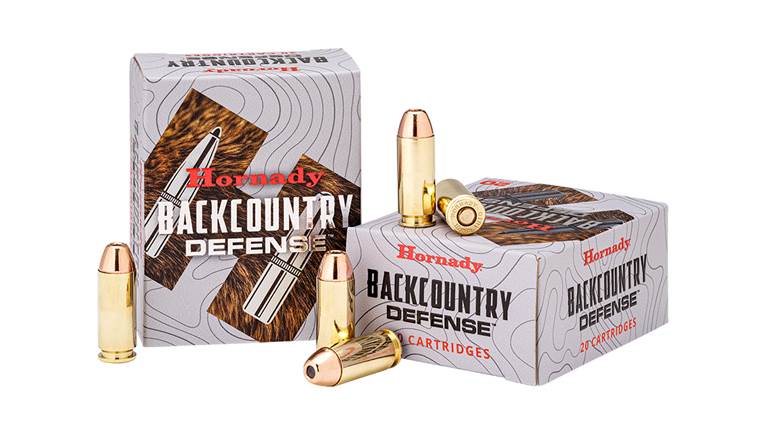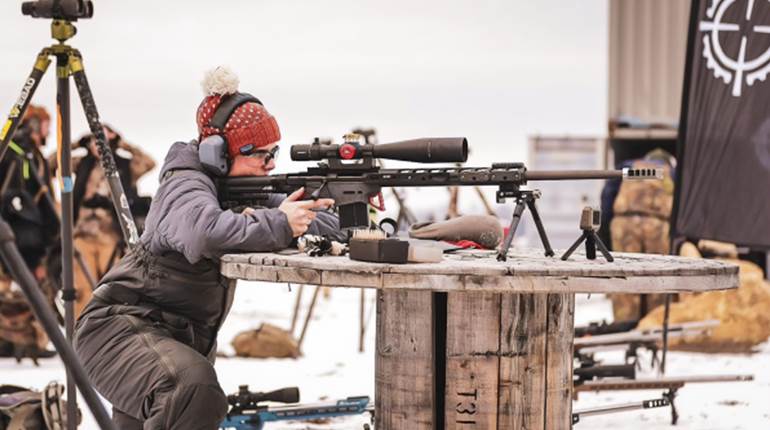
There hasn't been much talk recently about new .45 Colt/.410 handguns arriving on the market. However, the popularity of guns like the Taurus Judge, Smith & Wesson Governor and the Bond Arms Snake Slayer have inspired ammunition companies to provide customers with shotshells specially designed to perform in the short, rifled barrels of handguns. Federal, Remington and Winchester all have fingers in this particular .410 pie, and so Hornady has stepped up to the plate with a new .410 handgun shotshell unlike anything else currently available.
The Hornady Critical Defense 2 ½-inch .410 Triple Threat shotshell contains a mixed payload, unlike the buckshot loads that are loaded with three, four or five lead balls of the same diameter. The first projectile in the Hornady shell is a .41-caliber 115-grain FTX lead slug. The un-jacketed slug's hollow-point nose is filled with a red polymer plug, just like the copper jacketed FTX bullets used in the standard pistol-caliber cartridges of the Critical Defense line. The slug is followed by two .35-caliber lead balls weighing in at 65 grains each, which means they are slightly smaller and lighter than 000 buckshot pellets. This makes for a total of 245-grains of lead to throw downrange, which is about 15-grains more than a standard .45 ACP FMJ bullet at a published velocity of 750 feet-per-second (fps).
But here is an important question: Why does Hornady, or any company for that matter, need to design .410 shells specifically for handguns? Wouldn’t any .410 shell of correct length for the chamber do the trick? This need for handgun-specific shotshells is actually driven by a bit of government policy.
The most efficient handgun for shooting .410 shells would have a smooth-bore barrel sized to fit that shell only. However, sawed-off shotguns and smooth-bore pistols have been restricted in this country for some time due to NFA regulations established in 1934. In order for a handgun to qualify for over-the-counter sale without additional Federal tax stamps and paperwork, it must have a rifled barrel and be chambered for a center-fire cartridge intended for handguns or rifles.
Therefore, the reason .45 Colt/.410 handguns are legal to buy over-the-counter (in most States) is because they are designed as .45 Colt pistols first, and as .410s second. In other words, the barrels are bored and rifled to fire the .452 to .454 caliber bullets of .45 Colt cartridges in order to meet NFA requirements, but the chambers are lengthened to accept shotshells. Meeting these legal requirements creates a functional gap between the two calibers. Sending .410-caliber projectiles from a shotshell down a .45-bore revolver barrel leaves a meaningful amount of airspace around the projectiles which in turn affects long-range accuracy. What may seem like absent minded gun design is actually a concession to Federal law.
Various ammunition companies strive to bridge the .45 Colt barrel/.41-caliber projectile gap in different ways. Hornady tackled the problem with the Triple Threat .410 shell. Along with having a hollow point, the relatively long and heavy (compared to buck shot) FTX slug has a hollow base. As the shell is fired, the two lead balls press into this hollow to cause the base of the slug to flair out and contact the rifling of the barrel. The goal is to have the slug produce the point-of-aim accuracy and expansion of a hollow-point bullet, with the lead balls spreading apart to create the pattern of a buckshot load. So how well does it work?
The Hornady Triple Defense shot shell was test fired through a set of six .45 Colt/.410 handguns and one .410 bore shotgun for pattern, penetration and performance testing. Just in case you're wondering, the answer is yes the Triple Defense shell can be safely fired in most .410 shotguns, including those with full chokes. Because this round is advertised as a self-defense shotshell, all of the test guns used were designed for personal protection or concealed carry.
Slug and ball patterns for each firearm were captured using two Birchwood Casey Shoot-N-C 12x18-inch silhouette targets, one up close, with one further out, to obtain the spread of the projectiles over distance. It should be noted here that .410-capable handguns cause the patterns of birdshot, buckshot and mixed payload .410 shells to open up very quickly compared to .410 long guns. While an 18.5-inch barrel combat shotgun in 12 gauge, 20 gauge or .410 bore can produce something like a 7-inch shot pattern at 21 feet (7 yards), some .410 handgun and ammunition combinations can produce 7-inch patterns in as little as 6 feet. The patterns produced with the Triple Threat were tight enough to provide representative test targets out to 10 feet and 15 feet for handguns, and 15 to 20 feet for the shotgun.
To check for projectile penetration and performance, single rounds were fired into bare Clear Ballistics FBI-sized synthetic gel blocks from a distance of 10 feet. Projectile expansion was checked using Sinclair digital calipers, and weight retention was verified with a Hornady GS-1500 electronic scale, both from Brownells.
So once the smoke cleared, how did Hornady's new Critical Defense 410 Triple Defense shotshell measure up? It demonstrated positive qualities in several areas, but mixed results in others. The shell proved to be reliable. It successfully fed, fired and ejected from a wide variety of guns with no malfunctions or failures. Function testing included several gun models that were not listed as part of this test.
The mixed-payload pattern testing has to be judged within the context of the firearms used. The .45 Colt/.410 handgun platforms are short-range personal-protection options. This means defensive .410 shotshells usually provide their best performance at around 7 yards or less. Much beyond 7 yards (depending on the load fired), the shot pattern becomes too large or the projectiles lose too much energy to be effective. This is the major trade-off of choosing this particular type of two-caliber handgun. It can launch multiple projectiles with one pull of the trigger, but at the cost of long-range accuracy and energy.
To even the playing field between the very shortest barrels (2-inches or less), the standard 3-inch barrels and the 18.5-inch shotgun, each gun had one of the two targets set at 5 yards to create a baseline. At this distance, patterns ranged from 1.25 to 3.5 inches in size, with the tightest single group of 1.25 inches produced by the standard-size Taurus Judge with a 2½-inch chamber and 3-inch barrel. Informal testing out to 7 yards demonstrated that every gun model tested could keep all three projectiles center-of-mass.
The Clear Ballistics gel testing demonstrated that relatively small changes in handgun barrel length may significantly alter the Triple Threat's slug and ball penetration levels. The most shallow three-projectile penetration distances (8.85, 7.75 and 7.25 inches) were produced by the 2-inch barrel of the Polymer Public Defender version of the Taurus Judge. However, the best handgun penetration (15, 12.25 and 10.25 inches) came from the 3-inch barrel of a standard sized Judge. To meet FBI standards, a projectile needs to produce a minimum of 12 inches of penetration in ballistic gel. Of the seven guns used in this limited gel test (one shot per block per gun), two had no projectiles reach 12 inches, five had one slug or ball hit or pass the 12-inch mark, three guns had two projectiles make the grade, but only one gun, the shotgun, pushed all three projectiles past 12 inches.
Those slugs or balls that satisfied the FBI’s 12-inch minimum distance requirements created what could be considered primary wound channels. The secondary wound channels caused by the other projectiles showed penetration distances ranging from 6 to 11.5 inches in depth. Although these secondary wound tracks don't meet the FBI grade, having two perforations at these depths added to the primary impact is nothing to laugh at.
Lastly we have the slug and ball performance results. The recovered pellets all held together nicely in gel, with the recovered projectiles retaining between 98 to 100 percent of their unfired weight. The lead balls showed some flattening, but not much. The most dramatic FTX slug expansions were produced by the Mossberg shotgun and, once again, the standard-sized Taurus Judge. In the shotgun, it looks like one ball and the slug slammed into each other causing both to be deformed. Unfortunately, the overall performance of the FTX slugs was disappointing. Take a look at this photo of the recovered slugs:

The hollow bases of the FTX slugs from this batch of shells did not expand enough to engage the rifling of the handgun barrels, which is the purpose of the slug’s design. In fact, the slugs displayed no rifling marks at all. Checking the base expansion with digital calipers confirmed what the visual inspection implied. No slug base expanded more than .444 inches when fired from a handgun, which means they were unlikely to engage the lands and grooves of a barrel designed for .454-inch .45 Colt bullets.
The polymer-tipped hollow points of the slugs showed very little to no expansion in five of the seven guns tested. In a few cases the unexpanded slug stopped in the gel facing backwards (tip toward the shooter). Was this dual failure to expand a fluke or a flaw? I've seen the same photos and gel tests, with fully expanded FTX Slugs, as everyone else. So what was the problem in this case? I can't say for sure. The rounds used for these tests were some of the very first Triple Threat loads off of the production line. Were the slugs in this batch made of a harder lead alloy? Were the powder charges off a bit? Or does Hornady have to go back and take another look at the design? Only time will tell for sure.
So, is the performance of the new Hornady Triple Threat .410 shotshell up to snuff? Based on these tests, it seems likely that the Triple Threat shell has been optimized for use in the Taurus Judge 2½-inch chamber, 3-inch barrel revolver. It also performs well when fired from a defensive shotgun. However, other short-barrel handguns may or may not produce sufficient levels of performance for self-defense. If Hornady can adjust the FTX slugs to expand fully at the base of the slug, then this round has the potential to become a top contender in this handgun ammunition class. For a complete set of test results, see the following table. For more information on .410 handgun and shotshell performance, visit 410Handguns.com.







































